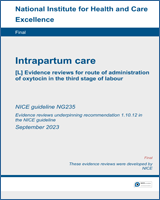From: Evidence reviews for route of administration of oxytocin in the third stage of labour

Evidence reviews for route of administration of oxytocin in the third stage of labour: Intrapartum care: Evidence review L.
NICE Guideline, No. 235.
London: National Institute for Health and Care Excellence (NICE); 2023 Sep.
Copyright © NICE 2023.
NCBI Bookshelf. A service of the National Library of Medicine, National Institutes of Health.